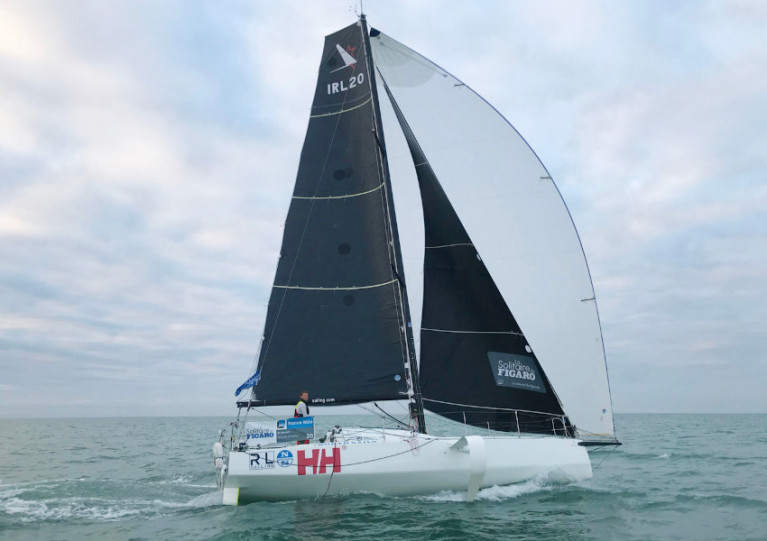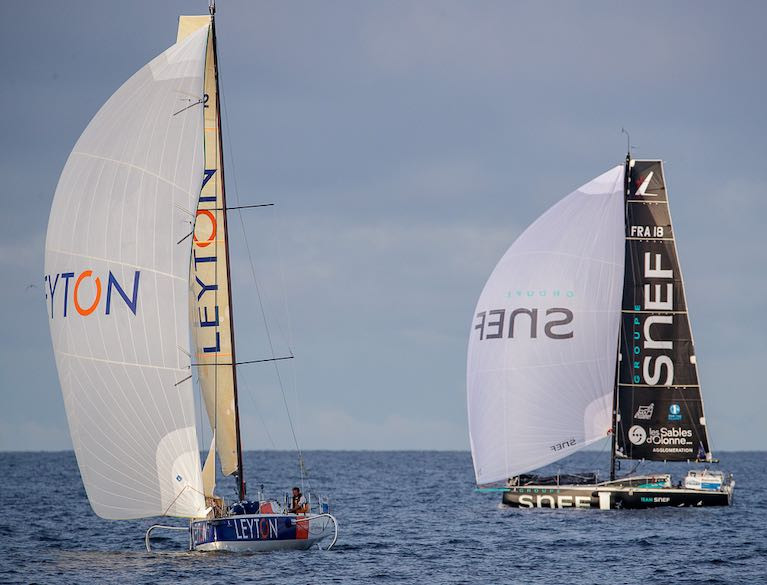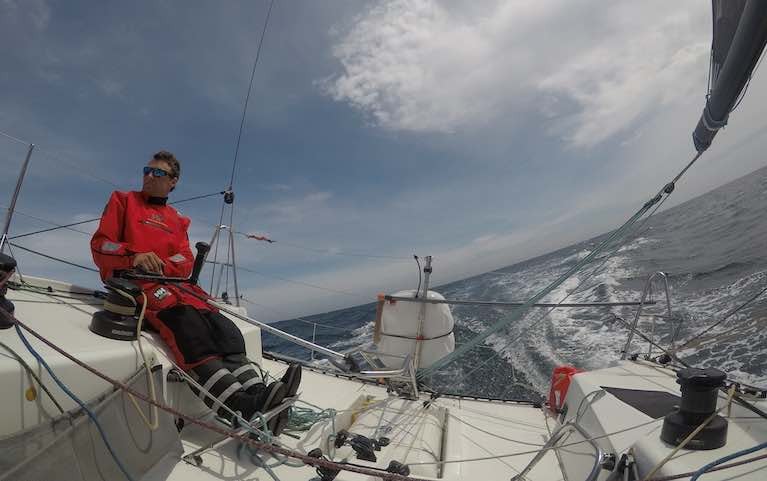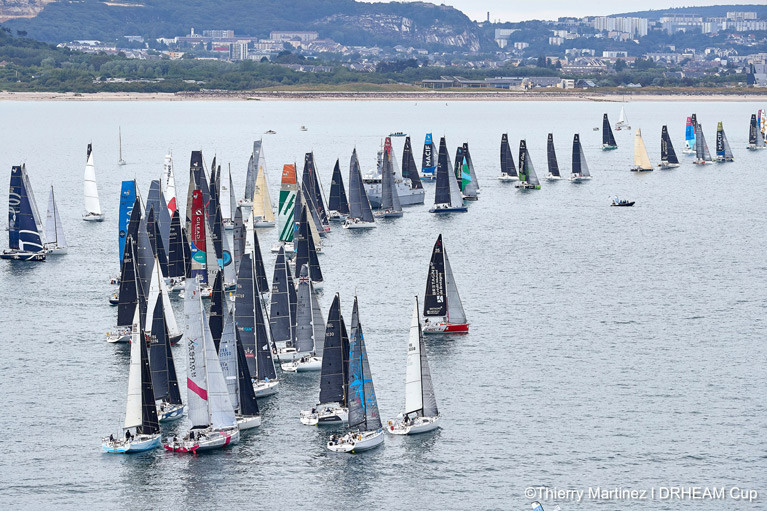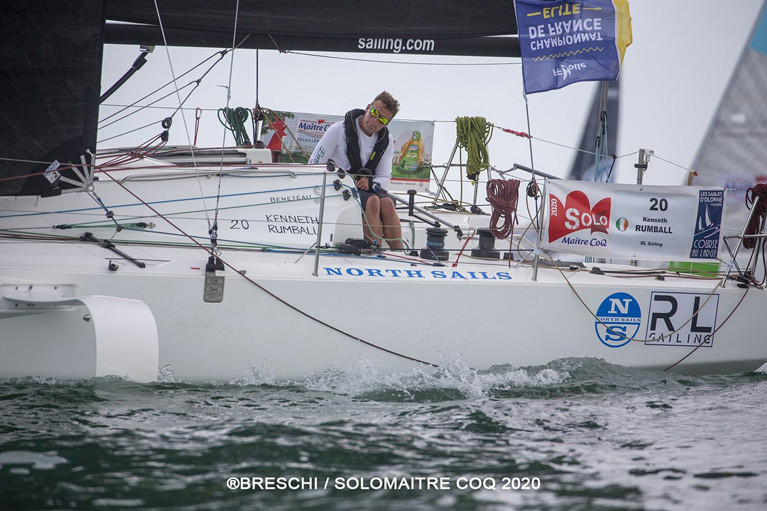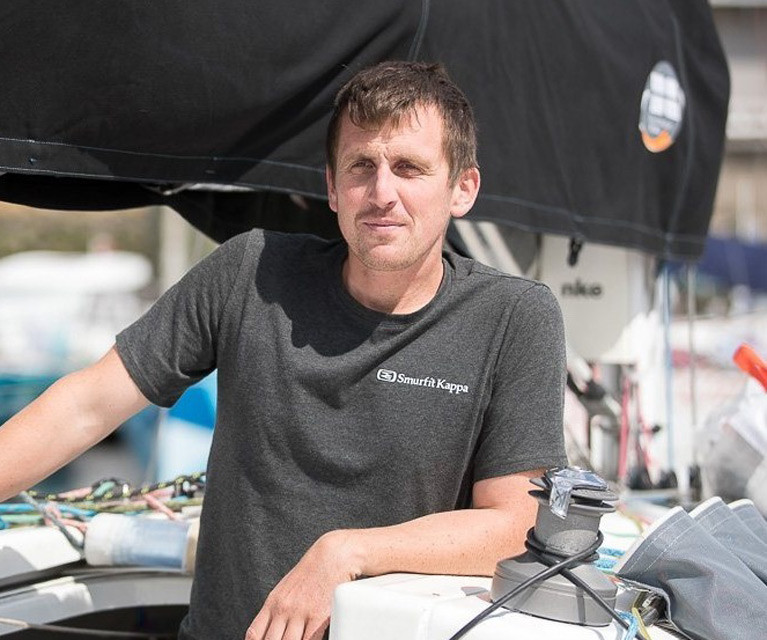Displaying items by tag: Figaro
County Meath solo sailor Tom Dolan is confident he will be fighting fit for the double-handed Transat en Doible Concarneau to Saint Barthelem which starts May 9th. This is despite an ankle injury sustained by Dolan in the Season Opening Solo Maître Coq at the weekend.
As Afloat reported earlier, the Irish Sailor of the Year sustained the ankle injury midway through the 340 nautical miles long offshore race curtailed Dolan’s chances of a top 10 overall finish in the first solo race of the French Figaro season.
At the Ile de Ré, the southernmost turning point of the course, the skipper of Smurfit Kappa was comfortably racing among a strong breakaway group of ten leading the 29 strong fleet, when he overbalanced while stepping back into the cockpit of his Figaro Beneteau 3 and landed heavily, hurting his ankle and injuring his hand.
At first, in the light airs he tried to carry on but as the wind and seas built with the arrival of a front, the pain was scarcely bearable and it became obvious to Dolan that he had no alternative but to retire into Lorient. A medical examination has subsequently confirmed his ankle is badly sprained with some nerve damage. He has been told to rest his leg for three weeks to one month.
“It is just one of these things. I had had a problem with the tack line and had been up to the bow to fix it and I just stepped awkwardly back into the cockpit. I hurt my left hand and right foot. It is a lesson to be more careful in the future. I’ll lose a little bit of training time before the Transatlantic Concarneau Saint Barths but I am staying positive. I had sailed well in the opening races and was up with the top group when it happened so I am not despondent.” Dolan reported today (Monday) after finally being reunited with his phone which was left (according to the race rules) in Les Sables d’Olonne, the start and finish port.
“Initially I was determined to go on and finish but as the wind and seas built up it was apparent how immobile I was and it was clearly dangerous to go on.” He recalled, “I will be so much more careful in the future.”
Having finished seventh and 13th in the two inshore races last Monday and Tuesday, Dolan had started the offshore race in ninth place. Even counting the ‘RTD’ (retired) from the offshore race he still finished 18th, still his best result in the season opener yet.
“Look I am pretty happy nonetheless. I was good all round and was with the breakaway group and was going well. Overall I have good speed. I am still not very quick under gennaker and so that is a work in progress, I am not slow but neither am I the fastest. Meantime I have two or three weeks of physiotherapy to get on with and will be taking it carefully.” Tom Dolan concluded today.
Tom Dolan's First Test of 2021 at the Solo Maitre Coq Regatta
Ireland's Sailor of the Year Tom Dolan gets his first test of the 2021 season this week when he races in the Solo Maitre Coq Regatta in the Figaro Beneteau 3 foilers.
For two days, the Dolan among a fleet of 29 face each other on inshore courses in the bay of Les Sables d'Olonne with the big race of next week on Thursday, routing the skippers around the islands of Re, Yeu and Belle-ile.
Known in France, where he is based, as L’Irlandais Volant (the flying Irishman), Dolan put his Figaro 3 Smurfit Kappa back into the water in February and began his first training sessions from Lorient, ahead of this week's first races of 2021.
Over the last week, the Lorient training group made a round trip from Lorient to Concarneau.
The Solo Maitre Coq is taking place behind closed doors. No visitors are allowed on the Vendee Globe pontoon.
Dolan lifted the Irish Sailor of the Year award in February, now in its 25th year, the top award is presented by Afloat magazine and recognises not just his 2020 La Solitaire success but his sixth place overall in the French Elite Offshore Racing Championship.
Solo Maitre Coq 2021 Provisional programme
Friday, March 19
9h: Deadline for the arrival of the skippers and their boat at the Port Olona race pontoon - Tonnage checks.
Monday, March 22
9:30 am: Departure from the pontoon and up the channel.
11 am: Departure off the first leg.
Tuesday, 23 March
9:30 am: Departure from the pontoon and up the channel.
11am: Departure off the second round.
7 p.m .: Official evening - Dinner.
Thursday, March 25
11am: Departure from the pontoon and up the channel.
1 p.m .: Start of the big race.
Saturday, March 27
Arrival of the offshore race.
Sunday, March 28
11:30 am: Prize giving.
Kenny Rumball & Pamela Lee Set the Scene for Irish Offshore Sailors with North Sails Set-up
Rookie Kenny Rumball competed in his Figaro debut this autumn, reaching as high as 15th in the third stage in the notoriously tough French solo marathon event that saw the Dubliner end up 33rd from 35 starters overall.
It marked the first big challenge of his and his co-skipper Pamela Lee's campaign for a spot in the new Olympic mixed double-handed offshore event currently set to debut at Paris 2024.
But also key to their ambitions is their sail wardrobe, and Rumball and Lee enlisted the help of Nigel Young and his team at North Sails Ireland to see them right.
“With our training schedule, I didn’t want to buy sails and then go back and ask for things to be changed,” INSS head Rumball tells North Sails. “I wanted sails that worked would be fast and long-lasting. Nigel Young was my first call to make that happen.”
The pair’s full 3Di set-up got its first proper workout in this year’s La Solitaire du Figaro — one of the few major sailing events that managed to run safely amid the continuing Covid-19 upheaval.
And more recently, Lee took out the Beneteau Figaro 3 with Catherine Hunt and set a new WSSR-recognised round Ireland double-handed world record, demonstrating the powerful combination of skilled sailors, boat and sails.
North Sails has more on the story HERE.
Ireland’s Tom Dolan Scores Career Best Seventh on Stage 3 of La Solitaire, Fifth Overall
The newfound more robust, cool-headed approach continues to work for Irish solo sailor Tom Dolan who today finished seventh on Leg 3 of the 51st La Solitaire du Figaro, an epic four day 492 miles light winds slog from Dunkirk all the way down the Channel, around the Brittany peninsula finishing off Saint Nazaire on the Loire estuary this evening.
As Afloat reported earlier, The best ever finish of his three La Solitaires to date sees the 33-year-old skipper of Smurfit Kappa rising to fifth overall in the 33 strong fleet 1 hour and 29 minutes behind overall leader French skipper Armel Le Cléac’h but only 28 minutes shy of the podium.
No non-French skipper has finished on the overall podium since 1988 when Swiss skipper Laurent Bourgnon won. The best international finish overall recently was Britain’s Alan Roberts’ ninth in 2015, Ireland’s Damian Foxall was tenth overall in 1998 when he won the last leg.
The stage which started last Saturday afternoon from Dunkirk was raced mainly in light winds and passed through three major tidal gates where big gaps were opened up in the 33 boat fleet.
The final 30 miles today along the south Brittany coast were complicated and saw major upsets as the winds died completely. French ace Fred Duthil lead a breakaway trio offshore, outside Belle Ile island where they found more consistent breeze, they were able to pull back some eight miles of initial deficit to take the top three places.
Dolan was at one time leading the main peloton but was quietly delighted with his seventh place, adding to his 10th and 11th on Stages 1 and 2.
He wins the VIVI Trophy award for the best non-French skipper on the leg.
Dolan who was 32nd overall last year said: “To be honest with you I am a bit surprised because I really have not been doing anything different in the way I sail the boat, I trim the sails the same way and everything else but I really have made an effort to get my head sorted and so I don’t lose the plot a bit the way I maybe used to. And I really don’t focus on the other boats I just concentrate on my speed and trim and don’t get wound up where I am. But fifth overall, I better get some sleep before the last leg.”
He adds, “I am really enjoying the sailing much more too. That was a very hard leg, really very typical of what we had last year lots going on and very little time to sleep and recover. I had a bit of sleep on the first night but really very little since, but you really get very tired.”
Another Strong Performance for Tom Dolan in La Solitaire du Figaro Leg Two
There's another strong performance in the making for County Meath's Tom Dolan in the second stage of the La Solitaire du Figaro today with the third time Irish Figarista lying 11th in the 35-boat fleet, having been as high as fourth at one stage yesterday. Dolan, who finished tenth in the first leg, is expected to finish leg two this evening is currently ten miles off the leader.
Ireland's Kenny Rumball of RL Sailing from Dun Laoghaire is lying 33rd in his first-ever Figaro competition.
Two times La Solitaire du Figaro champion Armel Le Cleach (Banque Populaire) said before the start that he was 'going to be an opportunist' on this 51st edition. For the second time in as many stages the Vendee Globe winner has been true to his word but this time his risk was positively rewarded.
Prepared to hold further to the east, to leeward of his rivals on last night's beat from the north Brittany coast 100 miles to Eddystone Lighthouse, Le Cleac'h's slightly gutsy move was rewarded with a small jump on the pack which this Monday afternoon he has increased to a very useful 3.3 miles over a very compact group of pursuers. Transitioning an occluded front it may be Le Cleac'h was prepared to press his luck, but more likely he saw less cloud coming toward him and so was confident the front had evaporated and was therefore confident in his break away from the peloton.
Early on Stage 1 to the Fastnet and back Le Cleac'h chased his hunches and had strayed away from the pack and initially paid a heavy toll in miles to the leader. But a remarkable comeback got him to fourth at the finish, 10 minutes and 20 seconds behind stage winner Xavier Macaire. It not only got him into contention but also underlined that the 44 year old has ample speed and is very much a title contender. Indeed he would be top of the overall classification this afternoon if the race was stopped. With a new Ultime in build, the Vendee Globe title in his back pocket and the solid support of the French bank, Le Cleac'h has nothing to prove to the sailing world, or his peers.
At approaching the halfway point of the leg, with the winds due remain moderate to fresh for the remainder of the passage to Dunkirk the pacemakers should reach Dunkirk around 2000-2100hrs Tuesday evening.
'Nervous' Irish Rookie Kenny Rumball Embarks on La Solitaire du Figaro Challenge This Sunday
Ireland’s Kenneth Rumball is in the final preparation stages before starting his first La Solitaire du Figaro which start this Sunday, 30th August in the Bay of Saint-Brieuc. Having made the twenty-four-hour delivery up from Port-La-Foret on Sunday, Rumball’s Team RL Beneteau Figaro 3 is docked with the rest of the fleet in the marina at Saint-Quay Portrieux while any last preparations are made.
“This is my first season racing in the Figaro 3 and on courses around this section of the French coast, with all the changing schedules and restrictions due to COVID 19 I haven’t had the opportunity to do much training so I’ve found it really beneficial to do the deliveries to the race starts myself. It gives me a chance to spend real time on the water and to familiarise myself with some of the navigation in the race areas,” says Rumball.
Dun Laoghaire Harbour's Rumball was a latecomer to the Figaro 3 circuit this year, originally intending to campaign doublehanded with Irish Co-skipper Pamela Lee with the aim of representing Ireland in the first Doublehanded Offshore Worlds, which were scheduled for October in Malta. When the Worlds and the majority of the rest of the planned schedule were cancelled, Rumball quickly made the ambitious decision to take on a solo campaign for the season, culminating in Le Solitaire du Figaro.
 Kenny Rumball will be racing around the Fastnet Rock next week in the first leg of the 2020 La Solitaire du Figaro Photo: Alex Courcoux
Kenny Rumball will be racing around the Fastnet Rock next week in the first leg of the 2020 La Solitaire du Figaro Photo: Alex Courcoux
“It’s very clear that the best way to get better at shorthand sailing is to compete in France with the French. The Figaro circuit is incredibly competitive with the best shorthand sailors taking part every year, the Solitaire is the pinnacle of this circuit and a great challenge as a sailor. My main goal this year is to learn as much as possible and the learning curve has certainly been steep!” says Rumball.
"We are still on the vertical climb of this learning curve!"
So far Rumball has raced in the Solo Maitre-Coq from Les Sables D’olonne, the Dhream Cup (doublehanded) from Cherbourg-en-contentin and the Solo Guy Cotton from Concarneau. The Solo Guy Cotton was the last lead up race before the Solitaire and was a final opportunity to really focus on addressing a number of speed deficiencies, to test the new North Sails wardrobe, as well as experiment with managing sleep while racing – one of the biggest challenges. It proved to be a tough race with very fluky, light wind conditions. “Although disappointed with the final result, I took a lot of positives - good speed, smart decision making, good boat handling and above all strong mental power,” said Rumball of the race.
Now in the final days before the beginning of the first Solitaire leg, which is a 642-mile course to the Fastnet and back, Rumball is focusing on ironing out any last issues onboard, familiarising himself with the course and the navigation as well as analysing the upcoming weather and tidal patterns. Of course, a vital part of the pre-race preparation is mental and physical too, so there’s a strong focus on rest, eating well and exercise with an effort to be in a focused headspace on Sunday. “I’m certainly nervous,” says Rumball, “This is a long leg and a long time to be intensely racing with potentially some adverse weather coming through! So far the experience here in France has been great with all the other Skippers being extremely helpful and welcoming. This racing is tough, but that is exactly why we are here. We are still on the vertical climb of this learning curve!”
Tom Dolan Set For Final Warm-Up Before La Solitaire du Figaro
Ireland’s Tom Dolan sailing Smurfit Kappa is looking to the 380 nautical miles Solo Concarneau Trophée Guy Cotten, which starts Thursday, to confirm that he has everything in place for the season’s pinnacle solo event, the 1830 miles, four-stage La Solitaire du Figaro which takes place at the end of this month. The Solo Concarneau is the final key check-in for the solo fleet of Figaro Beneteau 3s before the annual La Solitaire.
Dolan will concentrate most on strategy and keeping a cool head during the three day long offshore which will take the fleet north to the notoriously rocky, very tidal Raz de Sein and south to Belle Ile as he seeks to follow up an excellent Drheam Cup last month when he finished second in the two-handed class and eighth overall. Racing then with his friend, Mini Transat winner François Jambou, “I am quite confident in the way I am handling the boat and my speed all round but the key is just to stay focused and not let things run away if I make mistakes. Racing with François we were able to sail up through the fleet after a less than perfect start, just making the right choices and taking things boat by boat. I have worked quite hard now on the mental side of the game and am definitely moving in the right direction.” Dolan commented as he returned Smurfit Kappa to the water this week after re-setting his rudders and routine maintenance and checks following the Drheam Cup. “Definitely I know that if I can keep my head together I can go fast enough to do well.”
Light winds are expected again around the 1500hrs start time Thursday and are likely to prevail at least through the first part of the race. “For sure that will make it interesting and challenging. That means lots of opportunities all the way through the race. I feel really good. Really, compared to this time last year it is just night and day, I feel fit and fresh whereas going into La Solitaire last year I was just exhausted with all that went into getting the new boats ready and learning them.” He explains, “I am sailing so much better than then, for sure, but the truth is that the fleet is getting faster and better all the time and you have to keep up. But here I can’t make stupid mistakes. That is the prime objective this time. I am not feeling under pressure to nail a result I just want to put together all the elements of a good race so I go to La Solitaire with confidence, knowing I can compete well.”
Dolan says he has also improved his starting and his first leg skills, claiming a ‘magic’ new strategy he believes can help launch himself from a stronger position rather than playing catch up too often.
If might seem to be the added comfort of starting out from home, Concarneau being his adopted home town, the race actually passes through the regular practice waters off Port La Fôret where almost all the top Figaro sailors have trained.
Thirty-two solo racers will compete in the Solo Concarneau which will see the timely return of French three times winner Yann Eliès. The race should finish Saturday afternoon.
Ireland's 'Figaro Duo' teams are racing in the 400-mile Drheam Cup and after a 1 pm start this afternoon are neck and neck in the seven-boat Figaro division.
Dun Laoghaire Harbour's Kenny Rumball and Pamela Lee are making their double-handed debut for Ireland and joining them on the Figaro Beneteau 3 fleet start line are County Meath and French combination Tom Dolan and Mini Transat Winner François Jambou.
As Afloat reported previously, both Rumball and Dolan are looking for a performance boost after both Irish solo sailors posted mixed results in the Solo Maitre Coq last month.
The race represents the start of the Irish campaigns for double-handed keelboat selection for Paris 2024.
The course started from Cherbourg Cotentin and finishes in Lorient and first takes the fleet across the Channel to the West Shambles mark off Weymouth, westwards along the English coast to Wolf Rock off Land’s End and then back across the entrance to the Channel to finish at Lorient, some time on Tuesday.
The 400-mile race mirrors some of what is likely to be part of September’s pinnacle event the La Solitaire du Figaro offshore in which Rumball and Dolan have their sights on.
It is the first time the Figaro Beneteau 3 fleet has been invited to race in this 100-plus boat event which has become a multi-class French offshore Grand Prix, set to feature the Ultime and IMOCA fleets too.
Dun Laoghaire's Rumball & Lee Ready for Drheam Cup as Dolan Teams Up With French Champion
Dun Laoghaire Harbour's Kenny Rumball and Pamela Lee make their double-handed debut for Ireland at the Drheam Cup on Sunday and joining them on the Figaro Beneteau 3 fleet start line are County Meath and French combination Tom Dolan and Mini Transat Winner François Jambou in what is the first major multi-class race on the French coast this season.
The 400-mile race mirrors some of what is likely to be part of September’s pinnacle event the La Solitaire du Figaro offshore in which Rumball and Dolan have their sights on.
Both Rumball and Dolan will be looking for a performance boost after both Irish solo sailors posted mixed results in the Solo Maitre Coq last month.
It will be the first time the Figaro Beneteau 3 fleet has been invited to race in this 100-plus boat event which has become a multi-class French offshore Grand Prix, set to feature the Ultime and IMOCA fleets too.
 Tom Dolan sailing with Mini Transat Winner François Jambou
Tom Dolan sailing with Mini Transat Winner François Jambou
The course starts from Cherbourg Cotentin and finishes in Lorient and first takes the fleet across the Channel to the West Shambles mark off Weymouth, westwards along the English coast to Wolf Rock off Land’s End and then back across the entrance to the Channel to finish at Lorient.
"We’ve had a bit of time off now with the boat in the shed getting antifouled and we had a chance to get the rig out ahead of the Drheam Cup. This we will do doublehanded, in line with the main aim of the programme" says Rumball who gives a nod to their Paris 2024 Olympic bid.
Dolan admits he did not do well on the Maitre CoQ. "That was disappointing so I am really looking forward to putting that behind me and sailing with Francois. We have been good mates for many years together and started a little business teaching and coaching people on the Mini, so we know each other well.” Dolan emphasises, “Our skills are complementary, we work well together. He has shown he can win races and so it will be good to have some fresh ideas and to be able to support each other. A second opinion is what you lack racing solo and so it will be nice to have that this time.”
The Drheam 2020 programme
- Thursday 16 July: Arrival of boats in Cherbourg-en-Cotentin
- Friday 17 and Saturday 18 July: Technical and safety checks
- Sunday 19 July: DRHEAM-CUP start
- From Tuesday 21 July: arrival of boats in La Trinité-sur-Mer
Early mistakes in very light and very fluky winds cost Tom Dolan dearly, leaving the Irish solo racer with no real chances to recover and make the solid opening he had wanted in the 340 nautical miles Solo Maître CoQ which finished on Saturday in Les Sables d’Olonne, France.
Dolan, sailing Smurfit Kappa, recovered a couple of hard-earned places in the latter stages of what was the first solo race of the 2020 season for the Figaro Bénéteau 3 fleet, to place 22nd.
He admits that once he had lost touch with the lead peloton on the mainly straight lines, reaching course there were not enough tactical opportunities to stage any kind of meaningful comeback.
The course off the Vendée took the fleet northwards in light winds from Les Sables d’Olonne to round the Ile de Yeu then a long southwards leg to the Ile de Re off La Rochelle. Dolan missed out on the first new breeze after a drifting start and then his losses were compounded by being on the wrong side of the next two rotations in wind direction.
“It is a disappointing way to start the season especially when we have waited so long to get racing. I know where I made the early mistakes and what is frustrating is that I didn’t really position myself early on to be able to follow my pre-race strategy which was to stay offshore where the new breeze was coming in from. I had it written everywhere ‘stay to the west’ but just could not get there in the breeze I had. Once I found myself in the east, to leeward you could not really climb back.” Dolan recalled Sunday after a decent night’s sleep. “Then it was all reaching.”
“ I sailed the boat well. I was fast enough and my manoeuvres were good and I take confidence in those fundamentals, but as ever I need to be with the lead group early on to really be able to sail the fleet rather than trying to catch up.” Dolan concludes.


























